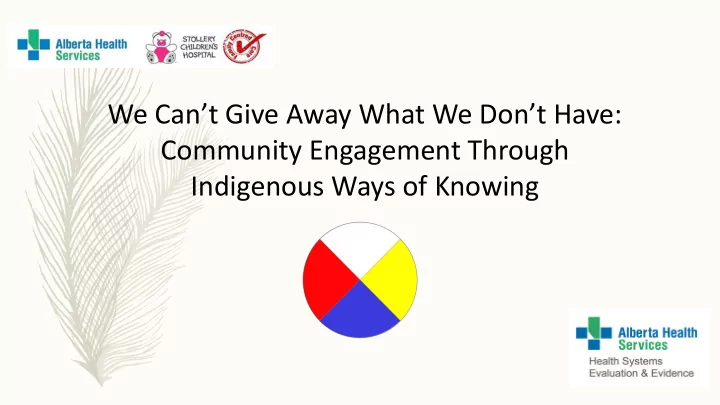

We Can’t Give Away What We Don’t Have: Community Engagement Through Indigenous Ways of Knowing
“ All that we are is story. From the moment we are born to the time we continue on our spirit journey, we are involved in the creation of the story of our time here. It is what we arrive with. It is all we leave behind. We are not the things we accumulate. We are not the things we deem important. We are story. All of us. What comes to matter then is the creation of the best possible story we can while we’re here; you, me, us, together. When we can do that and we take the time to share those stories with each other, we get bigger inside, we see each other, we recognize our kinship – we change the world, one story at a time…”
Stollery Children’s Hospital • Is a 150 bed children’s hospital that opened in October 2001 • The hospital is noted as a "centre for specialized pediatric services", as well as being the "referral centre for pediatric cardiac surgery in Western Canada and for organ transplants. The hospital contains a NICU, PICU and multiple other clinics geared towards children. • 50% of patients come from rural and remote communities with 35% of those patients being First Nations, Metis or Inuit.
Where are we going? Where we have been. Beginnings Culturally Appropriate Methodology Culturally Responsive Analysis Coming Full Circle
Awasisak = Children
How to engage before you Engage
Purp urpose: ose: A Vision ion Day ay to tal alk k ab about what at is the be best t car are e for r children dren an and d their r fam amilies ies at at the St Stol ollery lery
Let’s Have a Plan!
Principles (Methodology) Love Truth Respect 7 Sacred Teachings Humility Courage Wisdom Honesty
Protocols (Method)
Get em ’ Talking 1. What worked well for you? What challenges have you experienced? 2. What can the Stollery do to provide better health services for our children and improve/enhance patient family experiences while in the hospital? 3. What does your ideal transition to/from hospital and community look like?
Rock the Vote
Culturally Responsive Analysis Non-hierarchical Real-time Ongoing
Continuing the Conversation
The Little Program that Could 1.Indigenous HCPs 2.Discharge planning 3.Housing 4.Indigenous Health Science Academy 5.Outreach Team
Acting on Priorities 4. Jordan’s principle 5. Mental health 6. Supports 7. Cultural awareness and sensitivity 8. Indigenous diversity & support initiative
Indigenous Child and Family Engagement Coordinator - Algorithm Core Responsibilities Creating information packages Service logs and documentation Identify and share knowledge re: community and AHS Duties for Engagement resources and services with patient/families. Duties to Stollery’s Provide cultural, spiritual support Cultural teachings sessions Indigenous population Bridge builder i.e. familiarize families on function of Jordan’s Principal Supporter western medical services and help staff understand Creating a culturally Collaborate with Art Gallery the responses and reactions of Indigenous child and safe place and artists their family to those services Hospital Tours Supporting strong Accommodating/assisti relationships with Stollery ng families i.e. team Volunteer Initiatives appointments, bus Patient & Organize tickets, parking passes Family language Accessing off site services interpretations Ronald MacDonald House Smudging Ceremony Accompanying families Duties to Complement Healthcare Teams: Drumming Ceremony to feel safe in order to Hosting Weekly Tea Bridge with SW access community resources i.e. Jordan’s ask questions and Bannock Principle, Air Canada Foundation, Ronald McDonald House, Gaining Treaty/Metis Collaborating with etc. card access Ronald McDonald Facilitate linking family with SW House Consult SW by verbal, phone, email interactions with Indigenous Youth patients and families Health Careers Documenting interactions with families and emailing to their SW Partnering with SW to see what can be done to support Indigenous families on their unit (Timing on seeing patient)
Room to Grow 1. Sharing experiences, hopes, visions and dreams 2. Looking to the future 3. Determining needs
Acknowledgements We would like to acknowledge the talking circle participants for their time and effort; without their stories and willingness to share their experiences the ideas and recommendations would not be available to direct the efforts of the next steps of the Awasisak Indigenous Health Program. Participating communities include: Slave Lake, Edmonton, Bonnyville, High Level, Fox Lake, Fort McMurray: O’Chiese, Maskwacis, Metis Nations of Alberta, Alexander, Driftpile First Nation, Swan River First Nation, Sucker Creek First Nation, Bigstone Cree Nation, Beaver Lake Cree Nation, Kehewin Cree First Nation, Whitefish First Nation, Frog Lake First Nation, Cold Lake First Nation, Saddle Lake First Nation, Dene Tha’ First Nation, Chateh First Nation, Kapawe’no First Nation, Beaver First Nation Tallcree First Nation, Littl e Red River First Nation. We would also like to thank Audrey Thomas, Linda Sinal, Shawn Hillhouse, Chrystal Plante, & Heather McCrady for their generous contributions of time, expertise, and experience.
Hai Hai (Cree) Marsi Chok (Dene) Nitsiniiyi’taki (Blackfoot) Isniyes (Nakota) Thank You
Questions 1. Who are you? 2. How do you feel about what you have heard today? 3. What is one thing you will be doing differently going forward?
Recommend
More recommend